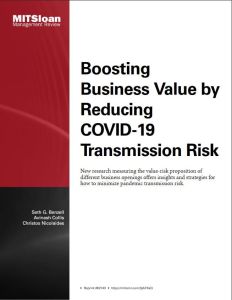Join getAbstract to access the summary!

Join getAbstract to access the summary!
Seth G. Benzell, Avinash Collis and Christos Nicolaides
Boosting Business Value by Reducing COVID-19 Transmission Risk
New research measuring the value-risk proposition of different business openings offers insights and strategies for how to minimize pandemic transmission risk.
MIT Sloan Management Review, 2020
What's inside?
How can your business remain viable while minimizing COVID-19 transmission risk among employees and customers?
Recommendation
COVID-19-induced lockdowns had a negative impact on brick-and-mortar businesses across the United States. As the US economy is starting to open up again, businesses must find ways to reopen without putting the health of their employees and customers at unnecessary risk. How can you avoid people clusters inside and in front of your location? Can you offer incentives so that people don’t show up at the same time? A group of MIT researchers offers a series of best practices.
Take-Aways
- Measuring the value-risk proposition of different types of brick-and-mortar business offers important insights to both customers and companies during the pandemic.
- Businesses can take several measures to boost their risk-to-value proposition.
- Some restaurants will find it easier to stagger scheduling than others.
Summary
Measuring the value-risk proposition of different types of brick-and-mortar business offers important insights to both customers and companies during the pandemic.
The economic impact of COVID-19-induced lockdowns and social distancing has varied widely between different types of business. You can derive the relative economic importance of a business by factoring in variables such as employee count, payroll, and the social and economic value of the business.
The transmission risk of various businesses also varies considerably depending on the number of visitors, the amount of social mixing, the ability of people to observe social distancing on the premises and the average age of visitors. A survey of 26 US location types has found that gyms and cafés have some of the worst risk-reward ratios: These types of locations are small, highly frequented and tend to crowd easily. They are also rated of low social and economic importance as their contribution to the national GDP, employment and citizen welfare is relatively modest. The same survey rated banks and grocery stores as having some of the best risk-reward ratios due to the high social and economic importance of the services they offer.
Businesses can take several measures to boost their risk-to-value proposition.
Businesses can boost their risk-to-value proposition by finding ways to reduce transmission risk at their premises. General safety measures such as frequent disinfecting and mask-wearing mandates can go a long way.
“The good news is that locations that offer the worst trade-offs due to COVID-19 have the best opportunities to improve their safety through customer timing and scheduling changes.”
Another effective measure is limiting the number of people on the premises. To avoid lines outside the store, which could result in infections, business owners and managers can issue time-restricted coupons for customer visits, which will nudge patrons to arrive at less busy times. Businesses may also create special hours for high-risk groups to visit. Particularly high-risk businesses like dental offices and restaurants can significantly reduce transmission risk through advanced scheduling.
Some restaurants will find it easier to stagger scheduling than others.
Restaurants can reduce transmission risk considerably by spreading out restaurant visits more evenly throughout the day. However, those restaurants or chains that are associated with a particular meal will find doing so more difficult.
“For example, IHOP (breakfast), Texas Roadhouse (dinner), and Buffalo Wild Wings (sporting events) all have above-average variance in crowdedness.”
Prior to the pandemic, for example, The Cheesecake Factory and Ruby Tuesday registered about the same average number of visits. Customer visits, however, have been much more concentrated during certain peak hours at The Cheesecake Factory, which will make staying viable harder for the restaurant.
About the Authors
Seth G. Benzell, Avinash Collis and Christos Nicolaides are Digital Fellows of the MIT Initiative on the Digital Economy.
This document is restricted to personal use only.

















Comment on this summary